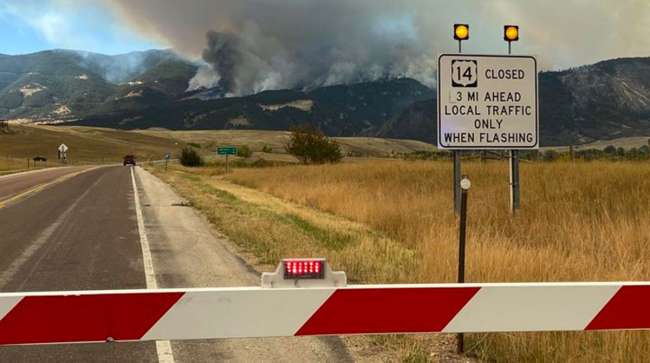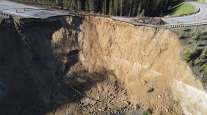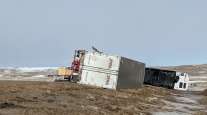Staff Reporter
Wyoming Wildfires Prompt Emergency Livestock Transport

[Stay on top of transportation news: Get TTNews in your inbox.]
With wildfires still threatening Wyoming’s landscape and livestock, Gov. Mark Gordon has renewed two emergency orders to streamline the transportation of animals and their feed. These measures extend hours of service for drivers and ease restrictions on vehicle weight and size limits for hauling livestock and feed.
Gordon’s action came ahead of U.S. Agriculture Secretary Tom Vilsack’s Oct. 1 designation of Campbell County — Wyoming’s third-most populous — and five other counties as primary natural disaster areas. This declaration allows agricultural producers to seek federal assistance after wildfires that have scorched 629,000 acres, mostly on private land.
“I appreciate USDA’s recognition of the incredible impacts Wyoming agriculture producers are experiencing this year due to wildfire,” Gordon said. “Fire season is not over in Wyoming. We have multiple large fires still burning, with more fire weather forecast for the coming days. It is critical that we all do our part and exercise caution when working and recreating in our beautiful state.”
Wyoming was battling three major wildfires in the first half of October. The uncontrolled Elk Fire rages near U.S. Highway 14, about 6 miles northwest of Dayton near the Montana border. Nearly 600 firefighters are combating this 73,000-acre inferno, which has forced the closure of U.S. 14 between Dayton and Burgess Junction. The fire’s cause remains unknown since its discovery Sept. 27.

Gordon
In the northeast, two lightning-sparked wildfires merged overnight Oct. 5. The Fish Creek Fire, discovered Aug. 16 and 87% contained over 26,313 acres, joined with the Pack Trail Fire, 60% contained over 54,487 acres. Now unified under the name Pack Trail Fire, this blaze has 417 personnel battling it. Evacuations are underway in the Upper Gros Ventre area of Bridger-Teton National Forest.
Meanwhile, the Clearwater Fire, which began July 19 about 11 miles west of Wapiti, is 93% contained.
These wildfires prompted Gordon to renew the emergency orders, as Wyoming’s agriculture is among the most important pieces of its economy. In 2021, the state had 1.25 million head of cattle and calves valued at $1.65 billion, according to a University of Wyoming report.
The first emergency order, effective through Oct. 13, relaxes federal restrictions on motor carrier driver operating times for livestock and feed transportation. However, it strictly prohibits fatigued drivers from operating vehicles.
“A driver who informs a carrier that he/she needs immediate rest shall be given adequate rest before the driver is required to return to service,” the order mandates.
Fire has started to burn in Sybille Canyon off of HWY34. Pre-evacuation orders are in place for WY 34 from MM13-18 and CR 12. Please avoid the area while crews work to address the fire.
Follow @albanycounty for up to date information as it comes in. pic.twitter.com/RzNqxwSlXH — WYDOT District 1 (@wydot1) September 12, 2024
Gordon emphasized that this year’s wildfires have consumed more than 100,000 acres, exacerbated by low humidity and high temperatures.
“These hazardous conditions created a shortage of livestock feed including depleted pasture grass and natural feed supplies in many parts of the state, resulting in inadequate livestock forage. Easing restrictions to transport loads of livestock feed and livestock is necessary to provide assistance to fire-stricken areas,” Gordon said.
Night Lights
For night travel, the order mandates special lighting requirements:
- Amber clearance lights on each front corner, and red clearance lights on each rear corner of the load or vehicle, whichever is wider.
- A revolving amber light, amber strobe light or two-way flashing amber lights at least 4 inches in diameter. LED assemblies meeting visibility requirements are permitted.
- All lights must be visible from at least 1,000 feet away, front and rear.
Source: Wyoming emergency order that extends daytime hours for transportation
The second emergency order focuses on vehicles hauling livestock and feed. It extends daytime hours for transportation, allowing oversize loads of livestock feed on state highways two hours before sunrise and two hours after sunset.
The Wyoming Highway Patrol will issue special overweight/oversize permits valid only for transporting livestock or associated feed within Wyoming or through states with similar declared emergencies. Vehicles must display oversize load signs on both front and rear.
Under these emergency permits, vehicles on state highways cannot exceed 12 feet, 6 inches in width or 15 feet in height, with no load component wider than 102 inches. Overweight vehicles are limited to 10% over allowed axle weights and no more than 5,000 pounds above the state-authorized gross weight.
The order clarifies, “This does not grant authority for any vehicle to exceed Class F weight limits or posted bridge and road limits of any such road.”
Want more news? Listen to today's daily briefing below or go here for more info:




